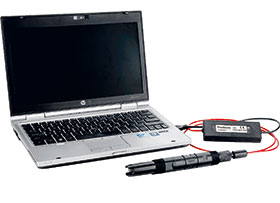

pH measurement
The pH of an aqueous solution indicates the concentration of hydrogen ions (H+), since this concentration determines the degree of acidity or alkalinity of the solution, The pH is therefore said to be a measure of the acidity or alkalinity and is defined as the negative logarithm of the hydrogen ion concentration: pH = -log [H+]
The pH scale ranges from 0 to 14 with a pH of 7 being neutral, a pH less than 7 being acidic and a pH greater than 7 being basic (alkaline). Measurement of pH by the 871PH sensor is accomplished by immersing the probe, which consists of integral pH and reference electrodes, in the process solution. The pH electrode is sensitive to hydrogen ions in solution and develops an electrical potential proportional to pH. The reference electrode, which consists of silver/silver chloride connected to the process via a potassium chloride salt bridge through a ceramic junction, provides a stable reference potential against which the glass electrode potential is measured. These two electrodes constitute a galvanic cell having a millivolt output proportional to the pH of the solution.
ORP measurement
ORP is a measure of the electrical potential of a reaction known as an oxidation-reduction (redox) reaction. A redox reaction is one in which one component loses one or more electrons (oxidation) while another component gains one or more electrons (reduction). The oxidation-reduction potential is related to the ratio of oxidation activity to reduction activity. By convention, a solution that contains an excess of oxidising agent has a positive ORP, and a solution that contains an excess of reducing agent has a negative ORP.
Measurement of ORP is accomplished by immersing a pH sensor, configured with a gold or platinum electrode, in a solution along with its integral silver/silver chloride reference electrode. This probe develops a millivolt output (similar to pH measurement) that is proportional to the ratio of oxidising agent to reducing agent, or ORP.
Foxboro provide a solution for pH measurement in some of the harshest and most abrasive industrial applications, for instance, wood pulp bleaching in the paper and pulp industry.
Technical challenges
In Kraft pulping, close to 90% of the wood is dissolved in the cooking liquor. The removal of the remaining lignin is completed through the bleaching process. In order to produce bright coloured pulp and paper the bleaching process must use several harsh chemical processes. The majority of bleaching processes rely on molecular chlorine, chlorine dioxide, hypochlorite, and peroxide as oxidising agents to remove the residual lignin from the cellulose fibre. A typical bleach sequence has two stages, each followed by an extraction stage. The bleaching stage is most efficient when operated at low pH levels (between 3,2 and 4,2). Conversely, the extraction stage is optimal when operated at higher pH (10,0 to 11,0), to maximise colour removal. Accurate and reliable pH measurements increase process efficiency, reduce maintenance costs and minimise the excessive use of chemicals.
Process conditions inside the bleaching towers are not only harsh on the process-wetted parts of a pH sensor, but can have a progressively detrimental effect on the life of a pH probe. The highly aggressive nature of the chemicals used as bleaching agents, along with the high solids inherent to the process and elevated operating temperatures, are all factors detrimental to most pH glass membranes. These factors will poison most reference electrodes in a short period of time, thus causing error in pH measurements, delay pH response times and shorten the useful life of a pH sensor.
The Foxboro solution
Foxboro’s Dolphin series pH sensors were developed with the understanding of this type of process. The high temperature glass formulation was developed specifically to withstand exposure to higher process temperatures and aggressive chemicals. When installed at the paper mill the results spoke for themselves. The evaluation process was a couple of weeks after which the mill realised the benefit. When compared in service with several other pH sensor types, the performance of the Dolphin series was deemed superior in many respects.
The sensor’s reference half-cell is designed to have a relatively small junction, which lessens the process infusion. A double reference junction was designed and incorporates Nafion technology, which has the unique property of being permeable only to positively charged ions (cations). Therefore, it effectively holds the concentration of chloride at the electrode at a constant level and delays the migration of soluble silver chloride, which has negatively charged ions, across its boundary. This Nafion ion barrier effectively prevents silver ions from migrating through the salt bridge and silver chloride in the external diffusion barrier, thus preventing clogging of the reference junction barriers, common cause of failure in these applications.
With more than 40 years’ experience in measurement, the proven reliability and robustness of the Foxboro Dolphin sensor, along with its intelligent analysers help improve process performance, increases production yields and reduce equipment and maintenance costs.
For more information contact Johan van Jaarsveldt, EOH, +27 87 803 9783, [email protected], www.eoh-pas.co.za

© Technews Publishing (Pty) Ltd | All Rights Reserved